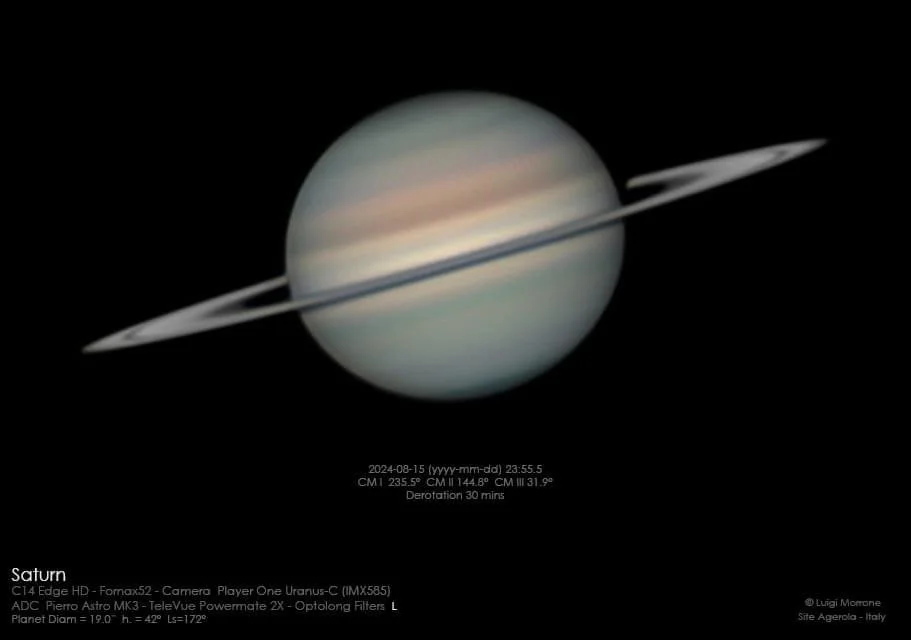
AAPOD2 Image Archives
Venus
Venus, often referred to as Earth's "sister planet" due to its similar size and composition, harbors some lesser-known intriguing facts. Unlike most planets in our solar system, Venus rotates in a retrograde motion, meaning it spins clockwise on its axis, opposite to the direction of its orbit around the Sun. This unusual rotation results in extremely long Venusian days, lasting longer than its years. Venus also boasts one of the most hostile environments in our solar system, with surface temperatures hot enough to melt lead and crushing atmospheric pressure akin to being 3,000 feet underwater. Furthermore, Venus has a mysterious phenomenon known as "super-rotational winds," where its thick cloud cover rotates much faster than the planet's surface, with winds reaching speeds of up to 224 miles per hour (360 kilometers per hour). These enigmatic features make Venus a captivating but challenging celestial neighbor to explore.
Saturn Tethys & Dione
Saturn's captivating moon system includes Tethys and Dione, two intriguing worlds of icy beauty. Tethys, the fifth-largest moon of Saturn, boasts a diameter of around 1,060 kilometers (660 miles). Named after the Greek Titan Tethys, it features the colossal Odysseus crater, spanning approximately 450 kilometers (280 miles). Tethys is further distinguished by mysterious reddish-brown streaks known as 'tiger stripes' that adorn its surface. Meanwhile, Dione, Saturn's fourth-largest moon, with a diameter of about 1,123 kilometers (698 miles), exhibits striking wispy cliffs, thought to be icy fractures. Discovered by Giovanni Domenico Cassini in 1684 and named after the Titan Dione from Greek mythology, these moons have been the focus of scientific exploration, including missions like Cassini-Huygens, which unraveled their secrets and unveiled their unique features.
Venus Bicolor
A new set of images taken under good seeing conditions. Interesting cloud features in the Infrared and Ultraviolet band can be seen.
Uranus
Image Description and Details :
After several weeks of a bad weather, the last night i am able to found good seeing conditions. The North Polar region results to be quite bright. The bright pole extends up to - 45°N. No relevant atmospheric activity in its upper layer clouds has been observed. Currently the Ice Giant planet is located about 19.7AU (2.95 bilion km) from the Earth.The false color image is only for aesthetic reasons.Setup: C14 EDGE HD, Fornax52 mount, ASI 290MM, Barlow Zeiss, Baader R+IR610nm.Below some Planet data:Solar Longitude Ls: 44°Declination of Earth De: +52.3°Diameter: 3.6 arc sec Agerola-Amalfitan Coast-Italy
Copyright: Luigi Morrone
Venus
Venus images taken on August 15 and 19, 2021. A 1 micron filter has been used.
Very interesting results to be the image of august 19, showing a vertical structure from the southern region.
The false color images are shown only for aesthetic reasons.
Setup:C14 Edge HD, Fornax52 Mountain, ASI 290mono, Barlow Zeiss, IR1000nm
COPYRIGHT: Luigi Morrone
Planetary Imaging 2020
Image Description and Details : The images have been acquired during the period February-October.For Jupiter and Saturn was a challenge since the planets were located about 26° above to the horizon.Setup used:C14 Edge HD Fornax52 mount ASI 178/290 mono Barlow Zeiss Baader filters RGB & IR>807nm IR>610nm UV320-380nm with ADC ZWO.
Copyright Information: Luigi Morrone








